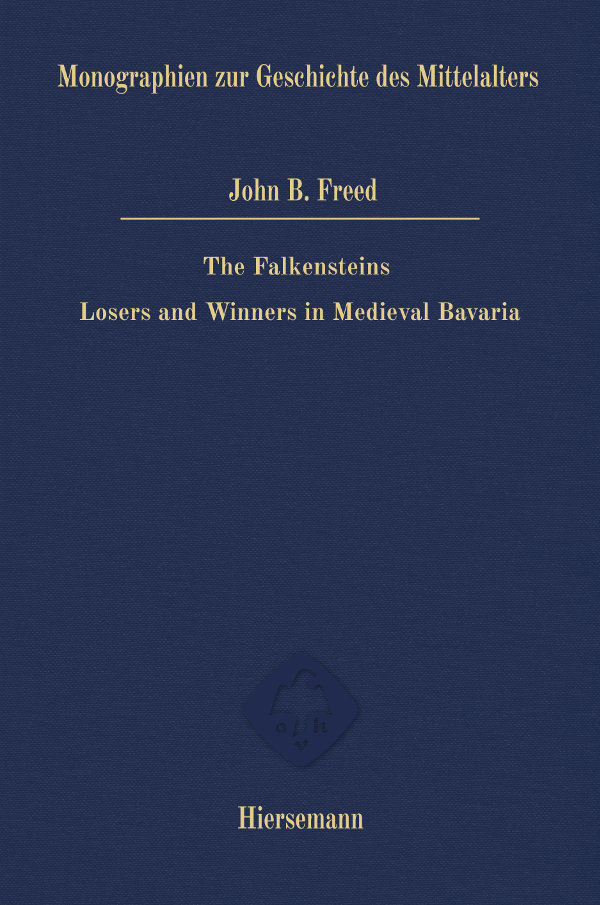John B. Freed is Distinguished Professor Emeritus of History at Illinois State University. He is the author of The Friars and German Society in the Thirteenth Century (1977); Noble Bondsmen: Ministerial Marriages in the Archdiocese of Salzburg, 1100–1343 (1995); and Frederick Barbarossa: The Prince and the Myth (2016).
John B. Freed
The Falkensteins: Losers and Winners in Medieval Bavaria Reihe: Monographien zur Geschichte des Mittelalters
Band-Nr.: 72
ISBN: 978-3-7772-2305-6
188,00 €*
The Falkensteins: Losers and Winners in Medieval Bavaria Reihe: Monographien zur Geschichte des Mittelalters
Band-Nr.: 72
ISBN: 978-3-7772-2305-6
The Codex Falkensteinensis ist the oldest extant medieval family archive. Count Sigiboto IV of Falkenstein commissioned the codex before joining in 1166 Frederick Barbarossa’s fourth Italian expedition and continued it after his return. It contains the earliest family portrait, the only book of conveyances (Traditionsbuch) from a secular lordship, the oldest accounts from the estate of a German lay lord, and the infamous „murder letter.“ It has been used to study agricultural, legal, and family history, but it has never been treated as a whole. Much of the analysis hinges on the placement of entries in the manuscript. The book explains why the Wittelsbachs were able to eliminate their erstwhile peers and consolidate their power.John B. Freed is Distinguished Professor Emeritus of History at Illinois State University. He is the author of The Friars and German Society in the Thirteenth Century (1977); Noble Bondsmen: Ministerial Marriages in the Archdiocese of Salzburg, 1100–1343 (1995); and Frederick Barbarossa: The Prince and the Myth (2016).
Subskriptionspreis für Bezieher der Reihe und für Vorbestellungen € 168,–, danach € 188,–
ContentsAbbreviations Introduction Chapter OneThe Welf Century Sigiboto of Weyarn, Berengar of Sulzbach, and Henry VThe Bad AdvocateThe Augustinian CanonsThe Second CrusadeFrederick BarbarossaThe Salzburg Schism and the Wittelsbach Accession Chapter TwoThe Codex FalkensteinensisTraditionsbücherThe Codex in 1166The Codex after 1166The German TranslationPragmatic Literacy Chapter ThreeAncestors: Imagined and RealThe Staufer and the WelfsBabenbergs and WittelsbachsLineages with Ninth-Century AntecedentsAndechses, Sulzbachs, and VohburgsChapter FourForebearsThe HantgemalDilching, Weyarn, Neuburg, and AiblingHernstein, Grikkingin, and WolfkersteinFalkensteinHartmannsberg and Antwort Chapter FiveThe PatriarchHildegard of MödlingHerrand IIThe Wicked UncleRudolf of PiestingSons and DaughtersIllegitimate Sons Chapter SixLords, Vassals, Friends, and Unfree RetainersFiefs and Vassals ReconsideredFriendsUnfree Retainers Chapter SevenThe Agricultural FoundationThe OfficesThe Problem of the FiefsThe Income from the AdvocaciesThe RendersWineMonetary PaymentsChapter EightThe End of the DynastyDuke Louis I, the KelheimerOtto IIThe Legacy Conclusion GenealogiesIllustrationsMapsBibliographyUnprinted SourcesPrimary SourcesSecondary SourcesIndex

